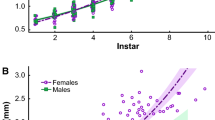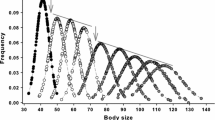Abstract
The evolution of the investment in exaggerated secondary sexual traits is a topic of great interest for scientists. Despite antlers in the family Cervidae being one of the most interesting allometric structures, the nature of the relationships between antler and body size, and the influence of physiological factors driving the evolution of these characters, still remain unclear. In this paper, I examine these relationships in depth using the largest sample size ever studied (43 species). Under the hypothesis that antler growth may be limited by skeleton size as this process requires the allocation of huge amounts of mineral resources to the antlers, skeleton-related variables may more accurately explain these allometric relationships. The existence of physiological constraints should therefore be more clearly highlighted when studying the relationships between body size variables and the relative investment in the antler (measured as length or mass of antler per kg of skeleton). Results show that antler length is best described as being linearly related to head-body length rather than other measurements of size, and antler weight has a quadratic relationship with body mass. However, the relative investment in antler length (related to skeleton mass) is independent of body size variables, while the relative investment in antler mass has a quadratic relationship with shoulder height. The results obtained for antler mass reflect the existence of physiological constraints in the evolution of antlers, which are greater for larger sized species. On the other hand, the evolution of antler length may be linked to other factors, most probably sociobiological and biomechanical ones.



Similar content being viewed by others
References
Barnes TG, Varner LW, Blankenship LH, Fillinger TJ, Heineman SC (1990) Macro and trace mineral content of selected south Texas deer forages. J Range Manage 43:220-223
Baxter BJ, Andrews RN, Barrell GK (1999) Bone turnover associated with antler growth in red deer (Cervus elaphus). Anat Rec 256:14–1
Bonduriansky R (2007) Sexual selection and allometry: a critical reappraisal of the evidence and ideas. Evolution 61:838-849
Bro-Jørgensen J (2007) The intensity of sexual selection predicts weapon size in male bovids. Evolution 61:1316–1326
Bruinderink GWTAG, Lammertsma DR, Hazebroek E (2000) Effects of cessation of supplemental feeding on mineral status of red deer Cervus elaphus and wild boar Sus scrofa in the Netherlands. Acta Theriol 45:71-85
Clutton-Brock TH, Albon SD, Gibson RM, Guinness FE (1979) The logical stag: adaptive aspects of fighting in red deer (Cervus elaphus L.). Anim Behav 27:211–215
Clutton-Brock TH, Albon SD, Harvey PH (1980) Antlers, body size and breeding group size in the Cervidae. Nature 285:565–567
Currey JD (1979) Mechanical properties of bone with greatly differing functions. J Biomech 12:13–19
Currey JD, Landete-Castillejos T, Estevez J, Ceacero F, Olguin A, Garcia A, Gallego L (2009) The mechanical properties of deer antler bone when used in fighting. J Exp Biol 212:3985–3993
Felsenstein J (1985) Phylogenies and the comparative method. Am Nat 125:1–15
Gaspar-Lopez E, Landete-Castillejos T, Estevez JA, Ceacero F, Gallego L, Garcia AJ (2010) Biometrics, testosterone, cortisol and antler growth cycle in Iberian red stags (Cervus elaphus hispanicus). Reprod Domest Anim 45:243–249
Geist V (1974) On the relationship of social evolution and ecology in ungulates. Am Zool 14:205–220
Geist V, Bayer M (1988) Sexual dimorphism in the Cervidae and its relation to habitat. J Zool 214:45-53
Gómez JA, Ceacero F, Landete-Castillejos T, Gaspar-López E, García AJ, Gallego L (2012) Factors affecting antler investment in Iberian red deer. Anim Prod Sci 52:867–873
Gould SJ (1973) Positive allometry of antlers in the “ Irish elk ”, Megaloceros giganteus. Nature 244:375–376
Grace ND, Castillo-Alcalá F, Wilson PR (2008) Amounts and distribution of mineral elements associated with liveweight gains of grazing red deer (Cervus elaphus). New Zeal J Agr Res 51:439–449
Huxley J (1931) The relative size of antlers of deer. Proc Zool Soc London 101:819–864
Johnson HE, Bleich VC, Krausman PR (2007) Mineral deficiencies in tule elk, Owens Valley, California. J Wildl Dis 43:61–74
Johnson HE, Bleich VC, Krausman PR, Koprowski JL (2007) Effects of antler breakage on mating behavior in male tule elk (Cervus elaphus nannodes). Eur J Wildlife Res 53:9-15
Landete-Castillejos T, Currey JD, Ceacero F, Garcia AJ, Gallego L, Gomez S (2012) Does nutrition affect bone porosity and mineral tissue distribution in deer antlers? The relationship between histology, mechanical properties and mineral composition. Bone 50: 245–254
Landete-Castillejos JD, Estevez JA, Fierro Y, Calatayud A, Ceacero F, Garcia AJ, Gallego L (2010) Do drastic weather effects on diet influence changes in chemical composition, mechanical properties and structure in deer antlers? Bone 47:815–825
Landete-Castillejos T, Estevez JA, Martínez A, Ceacero F, García JA, Gallego L (2007) Does chemical composition of antler bone reflect the physiological effort made to grow it? Bone 40:1095–1102
Lemaître JF, Gaillard JM (2013) Male survival patterns do not depend on male allocation to sexual competition in large herbivores. Behav Ecol 24:421–428
Lemaître JF, Vanpé C, Plard F, Gaillard JM (2014) The allometry between secondary sexual traits and body size is nonlinear among cervids. Biol Lett 10:20130869
Lincoln GA (1992) Biology of antlers. J Zool 226:517–528
Mattioli S (2011) Family Cervidae (deer). In: Wilson DE, Mittermeier RA (eds) Handbook of the Mammals of the World, Vol. 2. Hoofed Mammals. Lynx Edicions, Barcelona, pp 350–407
Muir PD, Sykes AR, Barrell GK (1987) Calcium metabolism in red deer (Cervus elaphus) offered herbages during antlerogenesis: kinetic and stable balance studies. J Agric Sci 109:357–364
Ohlson M, Staaland H (2001) Mineral diversity in wild plants: benefits and bane for moose. Oikos 94:442-454
Packard GC (2013) Is logarithmic transformation necessary in allometry? Biol J Linn Soc 109:476–486
Packard GC (2015) Allometric variation in the antlers of cervids: a comment on Lemaître et al. Biol Lett 11:20140923
Petrie M (1988) Intraspecific variation in structures that display competitive ability: large animals invest relatively more. Anim Behav 36:1174-1179
Plard F, Bonenfant C, Gaillard JM (2011) Revisiting the allometry of antlers among deer species: male–male sexual competition as a driver. Oikos 120:601–606
Rabinowitz A, Myint T, Khaing ST, Rabinowitz S (1999) Description of the leaf deer (Muntiacus putaoensis), a new species of muntjac from northern Myanmar. J Zool 249:427–435
Řežábek J, Bubenik AB (1963) The metabolism of phosphorus and iodine in deer. Translation Series AEC-tr-5631, U. S. Atomic Energy Commission
Rucker R, Storms D (2002) Interspecies comparisons of micronutrient requirements: metabolic vs. absolute body size. J Nutr 132:2999–3000
Techawiboonwong A, Song HK, Leonard MB, Wehrli RW (2008) Cortical bone water: in vivo quantification with ultrashort eco-time MR imaging. Radiology 248:824–833
Wagenmakers EJ, Farrell S (2004) AIC model selection using Akaike weights. Psychon B Rev 11:192–196
Wallace V, Davies AS (1985) Pre- and post-rut body composition of red deer stags. In: Fennessy PF, Drew KR (eds) Biology of Deer Production, Royal Society of New Zealand, Bulletin no. 22, Wellington, pp 291–293
Acknowledgments
The author thanks M. Komárková, J.L. Ros-Santaella, J. Pluhacek, L. Bartoš, and two anonymous reviewers for their valuable comments. This work has been funded by the projects MZERO0714 (Ministry of Agriculture), and IGA-20155013 (Faculty of Tropical AgriSciences - CULS).
Author information
Authors and Affiliations
Corresponding author
Rights and permissions
About this article
Cite this article
Ceacero, F. Long or Heavy? Physiological Constraints in the Evolution of Antlers. J Mammal Evol 23, 209–216 (2016). https://doi.org/10.1007/s10914-015-9310-0
Published:
Issue Date:
DOI: https://doi.org/10.1007/s10914-015-9310-0




